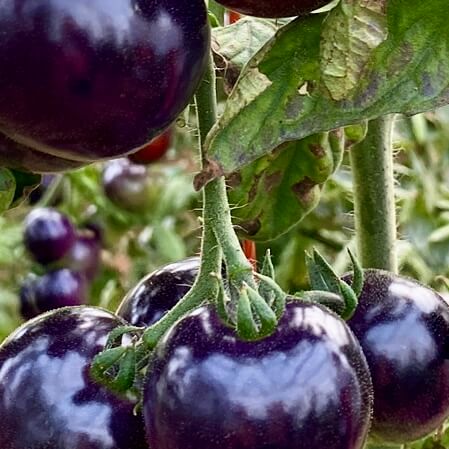Tomate (Solanum lycopersicum), Bekond
Kahlbach, Moselle tributary river kilometre 163
“All of them!” answers Gerhard Portz when asked about his favourite tomato variety. 40 different varieties are cultivated at Hofgut Portz in Bekond and are now harvested in August. Asa Portz is particularly enthusiastic about “San Marzano”, Noah prefers “Anacoeur”: “a large yellow heart tomato that is considered particularly aromatic and juicy.
“Valencia” is slightly striped, red and medium-sized, while “Artisan Pink” is a red-yellow striped elongated cocktail tomato. Bianea’ is also a cocktail tomato, but is creamy-yellow in colour. “Tuma Red” is a tomato salad and goes well with mozzarella and basil, which is also cultivated by the Portz family. On warm summer days, it smells here like warm summer days in Liguria.
“Marglobe” stands for flat, small, red tomatoes that are very aromatic, those of the “Aurica” variety are small and yellow. “Malea” is wrinkled, quite different from “Rio Grande”, an old bush tomato variety that is uncomplicated and robust. Kremser Perle” is a variety from Lower Austria, early ripe, with juicy, soft flesh, with a particularly balanced ratio of sweetness and acidity.
“Ricca” in its red-green striped dress attracts all eyes as a cocktail tomato; “Rio Lergo” is somewhat larger. “Indigo Apple’ has fruits that are black during growth. They are said to be particularly tasty when the shiny black of the sunny side has completely turned to matt purple.
“Kalami” is considered a rather inconspicuous variety – about the “jeans pants” among tomatoes, with which you can do no wrong? The answer to the question will have to wait, because we now come to “Marmande”. Mar-man-de – already the name makes you think of tradition and greatness. Yet its name probably has something to do with the town of Marmande. In the region of Nouvelle-Aquitaine, around 1870, after phylloxera had ravaged the vines of the region, this flesh tomato is said to have been increasingly bred and cultivated. A tomato of this variety can weigh up to 500 grams.
Although people like to think of Italy when they think of tomatoes, they have not been “native” there for long either.
Their wild form is distributed from northern Chile to Venezuela. In Central America, tomatoes were cultivated by Maya and other peoples from about 200 BC to 700 AD and called Xītomatl or.Tomatl (‘thick water’). They probably first came to Europe with Columbus around 1500. In the early 16th century, they are said to have been brought to Spain after the conquest of Mexico and called ‘tomate’ in reference to their Aztec name. In 1544, they were described in more detail by the Italian Pietro Andrea Mattioli: as a yellow fruit. In 1554 he wrote of red varieties, but still called them “pomi d’oro” (golden apples). In the 16th and 17th centuries, they were rarities symbolising prosperity in the gardens of the upper classes: ornamental plants that were considered poisonous.
Yet in 1658, an Antonio Latini, cook to the Spanish Viceroy of Naples, had noted three recipes with tomatoes in his cookbook. Around 1752, the Swede Carl von Linné called cultivated tomatoes “Solanum lycopersicum” and wild ones “Solanum peruvianum”. Tomatoes were shown at the Vienna World’s Fair in 1873, and around 1900 “Paradeiser” were available at the Viennese markets.
With a good 30 kilos per person and year, tomatoes are the most consumed vegetable in Germany today (including ketchup and the like). Fifteen years ago, it was 8 kilos less. According to the BZL (Bundesinformationszentrum Landwirtschaft, Bonn), barely 4 percent of the tomatoes eaten in Germany are produced here – although twice as many tomatoes are harvested here today as 20 years ago. They are imported from the Netherlands, Spain, Belgium, Morocco, Italy, France and Poland. The BZL also writes that tomatoes are the most important vegetable in the world with 190 million tonnes. “Europe accounts for about a fifth of this amount, while China alone is responsible for more than a third of world production.”
In Bekond, they are now in summer growing right outside the door. In more than 40 varieties.
(Sources: Wikipedia, BZL (Bundesinformationszentrum Landwirtschaft, Bonn), and own research)
